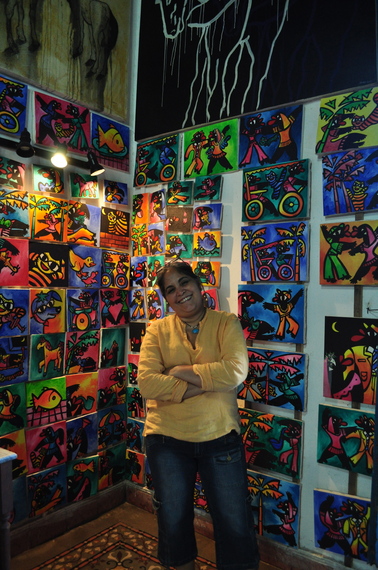Some people are surprised when I talk about the thriving art scene in Cuba. They assume the strictures of the socialist regime suppress any form of expression until only a bland diet of state-sanctioned work remains. This couldn't be further from the truth. With an utterly unique and peculiar socio-historical context, Cuban art in many ways stands alone.
Furthermore, it's everywhere; from private homes turned into open studios and small street galleries to lurid Afro-Caribbean murals on city walls. In addition to free education, there are multiple government programs assisting the arts. Castro's 1961 dictate -- "Within the revolution anything, against the revolution nothing" -- may still stand, but artists find multiple, subtle and stunning ways in which to negotiate and undermine this, often discovering even greater creative depths in the process.
But nowhere outside Havana seems such a hub of creativity as Camagüey, home to many of Cuba's most celebrated artists. Located in the middle of the country, Camagüey feels different to its neighbors, though with its history of defiance -- it has nurtured revolutionary poets and thinkers -- this comes as no surprise.
They say the city's twisted layout was designed to confuse and disorientate the pirates and pillagers who frequently ransacked the city. I purposefully lost myself in the labyrinthine streets imagining these gallivanting marauders and cowering citizens. With low rise, brightly colored houses, it feels distinctly South American. As the third largest city in Cuba, it is decrepit in parts, but the beautifully restored historical center was awarded UNESCO World Heritage Status in 2008, the 9th Cuban city to achieve this.
Emerging at Plaza del Carmen, I met a gathering of life size sculptures of everyday Camagüeyanos: a man read a newspaper sat on a bench; a pair of lovers embraces and a gaggle of women gossip over coffee. There was a spare chair amongst the women so I joined them, becoming part of the art. These characters feel distinctly Cuban: familiar scenes you've seen all over the country depicting the strength of community, the passion of the people.
There were also giant clay pots, called tinajones. Known as "the city of tinajones," the residents once used them to collect rainwater to stave off drought. Now the pots have become the city's trademark.
Just off the square, an open door invited me into a studio with vivid paintings, many addressing issues of women's rights. The artist Martha Petrona Jimenez was hard at work and I learnt they were her famous sculptures in the square. We sat in her leafy courtyard and talked about the arts in Cuba. She extolled working in Camagüey, saying this square in particular was home to many artists. She also told me about UNEAC, The National Union of Writers and Artists of Cuba. This organization has headquarters in every region and is a great place to start when on the hunt for talent. They host free events, talks and exhibitions, and often have a bar -- a great place to meet with the local art community.

Martha pointed me towards Joel Jover and his wife Ileana Sanchez (above), two of Cuba's most prodigious contemporary painters. Their home in the center of Camagüey functions as both gallery and a bona fide piece of art with every surface covered in work. Ileana greeted me, warm and welcoming, despite it being the end of the day. She talked me through their work. Her paintings were a celebration of color and glitter while Jover's were often darker, in a palette of red, white and black with religious undercurrents. They have collected antiques for 20 years -- they married in 1971 -- and every surface is covered in vintage toys and oddities. Ileana told me how her inspiration changes from day to day and how she feels deeply privileged to be able to make the art she wanted in this country. The implication I gathered was that not all others were so lucky.
Censorship is still rife and testing the boundaries a potentially dangerous endeavor. But, for us visitors, talking to artists and hearing their stories firsthand offers an unparalleled opportunity to understand this country and the complex realities of those trying not just to live here, but create something of beauty and value.
Tyler Wetherall is a freelance travel writer and editor, and columnist for U.S.-Cuba travel experts Insight Cuba, providing legal travel to Cuba for Americans.